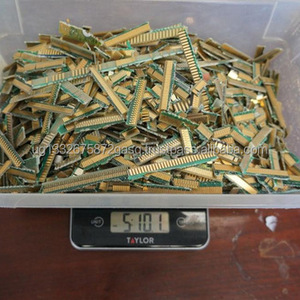
All categories
Featured selections
Trade Assurance
Buyer Central
Help Center
Get the app
Become a supplier

(4210 products available)













































Computer processor scrap is the central processing unit of a computer that is no longer useful or functional. It is removed to obtain valuable metals like gold and copper and can be recycled. The type of scrap processor is categorized by the generation of the processor. It can be either ceramic or plastic.
The first type of processor scrap is ceramic processor scraps. The ones that are made of ceramic are separated from the computer. The pins are visible on the ceramic processor. It is very easy to identify and is an older version of the processor. Ceramic processors are usually large and found in older computer models. They are heavier because the ceramic is denser than plastic. Ceramic is used to make the CPU heat resistant. Processors made from ceramic are much older, and new ones are made from plastic. The chips are visible on the outside, and ceramic processors are more delicate than the plastic ones.
Another type of processor scrap is plastic processor scraps. The processor is covered with a heat protector and is made from a type of plastic. It is less valuable than the ceramic processor. The plastic processor is lighter in weight than the ceramic one. It is also more common than the ceramic type of processor. The plastic processor is more durable than the ceramic one and less likely to break. It is also more resistant to heat than the ceramic processor. The CPU processors are more difficult to identify because of the plastic cover.
The function of a processor is to receive input data, process it, and give the output. Whether it is a central processing unit or a microprocessor, the purpose is the same. Its primary function is to run the computer system and manage its operations. It is considered the brain of the computer, which calculates different kinds of data and lets the computer execute instructions. It is the most important component of a computer system, and without it, the system will not function. The processor works closely with other computer components, such as the motherboard, to ensure the smooth functioning of the computer.
Computer processors come with multiple features that enhance their operation and ensure they can handle the workload. They include the following;
Processor scrap is mainly used for recycling and extracting precious metals like gold, silver, and copper. Besides this, the scrap is also used in sectors like manufacturing, construction, and electronics, among others. The following are some of the scenarios where processor scrap is used:
CPU scrap is used in the chemical industry for various reasons, like extracting precious metals. The industry is known to use scrap processors to manufacture valves, gaskets, and other intricate components found in chemical processing plants.
Scrap processors are used in electronics to manufacture electronic components. Besides this, the scrap is also used in the automotive industry to manufacture various parts of the car. For instance, the copper found in processor scrap is used to manufacture electrical wiring in cars. The plastic casing is also used to manufacture some parts of the car.
Construction is yet another industry that heavily relies on processor scrap. Precious metals like gold and silver are used in the plumbing and HVAC industries to make fittings and fixtures, among others.
Manufacturers use processor scrap for metal fabrication. The scrap is used to manufacture various tools and equipment used in the metal fabrication industry. These include items such as grinding wheels, fasteners, and many more.
Processor scrap is also used to manufacture parts of automated machinery. For instance, the lead found in the scrap is used to make batteries for automated machinery. The plastic casing of the scrap is used to make other parts of the machinery.
Processor scrap is also used in the jewelry industry. Precious metals like gold and silver are used to make various jewelry items. The industry is also known to make custom jewelry items from processor scrap.
When buying computer processor scraps, it's essential to look for a reputable supplier who has experience in scrap recycling. Buyers should also consider the pricing of the scrap and compare prices from different suppliers. They should also inquire whether the supplier provides after-sales services. They should also confirm the origin of the scrap and ensure that it is obtained legally. Buyers should also request to see the certifications of the supplier to ensure that the processor scrap is authentic. Additionally, they can order a small quantity of the scrap to examine the quality. Buyers should also ensure that the processor scrap meets their requirements before placing an order.
Q1: What can be made from CPU scrap?
A1: Old CPUs can be sold to e-waste recycling centers. The center will extract valuable metals like gold, copper, and aluminum and safely dispose of the rest.
Q2: Is it worth refining gold from CPU scrap?
A2: CPU gold is valuable but expensive to extract. It is only worth refining if the CPUs are from old computers.
Q3: Which CPUs are the most valuable for scrap?
A3: Some Intel and AMD processors have a higher value for recycling scrap. The specific models include Intel 486, 386, 286, and 8086, as well as the AMD 286, 386, 486, K6, and K6-2.
Q4: How much gold is in a processor?
A4: The amount of gold in a processor varies. Generally, older CPUs contain more gold than newer ones. Some older CPUs may have between 0.2 to 0.8g of gold, depending on the model.
Q5: How to extract gold from a processor?
A5: To extract gold from a processor, start by cutting the gold fingers off the CPU. Afterwards, place the CPU in a mild acid, such as hydrochloric acid. The acid will dissolve other materials, leaving the gold behind. Then, use aqua regia to extract the gold from the remaining parts.